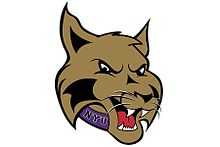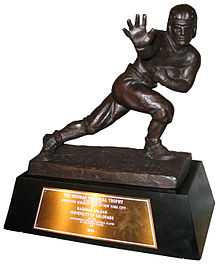NYU Violets
| New York University Violets | |
 | |
| University | New York University |
|---|---|
| Conference(s) | UAA |
| NCAA | Division III |
| Athletic director | Christopher Bledsoe |
| Location | New York, NY |
| Varsity teams | 19 |
| Basketball arena | Coles Sports and Recreation Center |
| Soccer stadium | No official home field; Home games usually played at Gaelic Park or the College of Staten Island |
| Mascot | Bobcat |
| Nickname | Violets |
| Fight song | |
| Colors | Mayfair Violet and White
|
| Homepage | NYU Athletics |
NYU Violets is the nickname of the sports teams and other competitive teams at New York University.[1] The school colors are the trademarked hue "NYU Violet" and white.
Although officially known as the Violets, the school mascot is a bobcat.[1] The Violets compete as a member of NCAA Division III in the University Athletic Association conference. The university sponsors 19 varsity sports, as well as intramural sports and club teams.
Nickname and mascot
For more than a century, NYU athletes have worn violet and white colors in competition, which is the root of the nickname Violets.[1] In the 1980s, after briefly using a student dressed as a violet for a mascot, the school instead adopted the bobcat as its mascot, from the abbreviation then being used by NYU's Bobst Library computerized catalog.[1]
History
NYU long offered a full athletic program, and was in fact a pioneer in the area of intercollegiate sports. When NYU began playing college football in 1873 it was one of the first football teams established in the United States (following Princeton, Rutgers, Columbia and Yale).[2][3] Additionally, the current governing body for collegiate sports, the NCAA, was formed as the direct result of a meeting convened in New York City by NYU Chancellor Henry MacCracken in December 1905 to improve the safety of football.[2]
However, in a process somewhat similar to what occurred with NYU's current conference rival Chicago Maroons, athletics were gradually deemphasized at NYU over the passing decades. The school terminated its intercollegiate football program in 1953.[4] In 1971 the basketball program was abruptly dropped.[5] In 1981, at the urging of then president John Brademas, NYU removed its remaining sports from NCAA Division I to Division III.[6] Still, NYU maintains a significant history of athletic success.
Intercollegiate sports at NYU also had moments of importance beyond anything shown by a scoreboard. In the 1940 season, before a football game between NYU and Missouri in Columbia, Missouri, 2,000 NYU students protested against the "gentlemen's agreement" to exclude African-American athletes (at the University of Missouri's request).[7] At the time, it was the largest protest ever against this practice.[7]
Division I

Since beginning play in 1873, NYU football has had many football players earn recognition for their achievements, most notably 1928 All-American and future Hall-of-Famer Ken Strong.[4] The most successful football coach in NYU history was Chick Meehan, who coached the team to seven successful seasons from 1925 to 1931. Additionally, the model for the Heisman Trophy is based on 1930s NYU football star Ed Smith.[2] Despite some shining moments, however, Time magazine characterized NYU's overall football history as mostly "lean" in 1942,[8] and NYU permanently dropped the sport as a varsity program after the 1952 season.[2][4]
While a member of Division I, the Violets' men's basketball program achieved far greater success than the school's football team. Its best NCAA tournament result was finishing as national runner-up to Oklahoma State (coached by the legendary Henry Iba) in the 1945 NCAA tournament. NYU returned to the Final Four in 1960, losing to Ohio State, whose roster featured legends Jerry Lucas and John Havlicek. NYU was even more successful in the years before the advent of the NIT tournament (in 1938) or the NCAA tournament (in 1939). In 1920 NYU won the Amateur Athletic Union national championship tournament, led by the Helms Athletic Foundation Player of the Year, Howard Cann, and the 19–1 NYU team of 1935 was named (retrospectively) by the Helms Foundation as the best team in the nation. The Violets' most recent post-season accomplishment as a Division I school was finishing as the runner-up to BYU in the 1966 National Invitation Tournament.
NYU maintained a nationally-ranked basketball team through the sixties with such stars as Barry Kramer and Satch Sanders, sending them to the NBA. The Violets played most of their games in Madison Square Garden, most notably their duels with UCLA led by Kareem Abdul-Jabbar. Less exalted local opponents like Fordham played in the field house on the Heights campus. The sale of the University Heights campus in 1971 further hampered attempts to create a football team, due to scant recreational space downtown. Several other valiant but ill-fated attempts have been made to revive football at NYU at club level, both as an intramural activity and as an intercollegiate sport. From 1964-1966, NYU participated with Georgetown in NYU’s first attempt to play non-division I football, reviving Georgetown football but not doing the same for NYU.[9] The same fate was met after club "competitions" with Fordham about two decades later.[10] As recently as 2003 several students created a football club but struggled to find extra funding to defray expenses, find supporters, or reliable participants for practices and games (held at the East River Park football fields at 6th and FDR.) [11]
The university's men's fencing team won the most NCAA Division I championships or co-championships prior to the NCAA's establishment of coed team competition in 1990. The twelve titles were earned between 1947 and 1976.[12] The women's fencing team has been national champions ten times—the women's foil team won the NIWFA's Mildred Stuyvesant-Fish Trophy from 1929 to 1933, in 1938, from 1949 to 1951, and in 1971.[13]
The National Intercollegiate Women's Fencing Association (NIWFA) was founded by NYU freshmen Julia Jones and Dorothy Hafner.
Division III

NYU, in its short history in NCAA Division III, has won two national team championships (and many league championships). The basketball program has enjoyed a good deal of success since being reinstated on the Division III level in 1983.[5] In 1997, the women’s basketball team, led by head coach Janice Quinn, won a championship title over the University of Wisconsin–Eau Claire and in 2007 returned to the Final Four. NYU men's basketball and head coach Joe Nesci appeared in the Division III National Championship game in 1994.
In 2007, the men's cross country team, led by head coach Nick McDonough, captured the NCAA Division III team championship at St. Olaf College in Northfield, MN.
NYU men's and women's swimming teams, under head coaches Bob Sorensen and Lauren Smith respectively, have done well in recent years capturing consecutive (2004-2005) Eastern College Athletic Conference (ECAC) Division III Swimming and Diving Championships. The women and men’s track and field teams, under coach Nick McDonough, practice at both Coles and the 168th St Armory. Christian Majdick of the men’s track and field team captured the NCAA Division III championship for the triple jump in 2003. Lauren Henkel, one of the most successful athletes in NYU track and field history, and the current assistant coach of the men's & women's track and field teams, acquired All-American status three times in the High Jump. The men's and women's soccer teams, under their respective coaches Joe Behan and Werner T. Dasbach practice at Pier 40 on the Hudson River. (Intramural clubs also practice at the East River Park soccer fields.) In 2003, the women's soccer team competed in the NCAA Division III Sweet Sixteen (top 16). The men’s soccer team won its league ECAC championship in the 2005-2006 season. However, the men’s soccer team’s most successful campaign came in the 2006 season, as the team set many records including total wins and longest streak without conceding a goal. Further, the team qualified for the Division III NCAA tournament for the first time in more than 30 years, reaching their first Final Four before losing to eventual champions Messiah College. They followed that up with a second consecutive NCAA appearance in 2007.
Facilities
The Coles Sports and Recreation Center serves as the home base of several of NYU's intercollegiate athletic teams, including basketball, wrestling, and volleyball. Coles is considered the center of recreational and athletic needs for the university's students, faculty, staff, and alumni. Coles has plenty facilities, such as weight rooms, squash courts, tennis courts, 25 meter swimming pool, basketball courts, and a rooftop running track. It also offers nearly 130 classes, serving about 10,000 members of the university community.
Many of NYU's varsity teams sometimes play their games at various facilities and fields throughout Manhattan because of the scarcity of space for playing fields in that borough. The soccer teams play their home games at Van Cortlandt Park, and the track and field teams have their home meets at the New Balance Track and Field Center. The golf team does not have a home golf course in Manhattan, but they often practice at the Chelsea Piers Athletic Facility and at various country club courses that have a relationship with the team and university in New York City.
In 2002, NYU opened the Palladium Athletic Facility as the second on-campus recreational facility. This facility's amenities include a rock-climbing wall, a natatorium with a 25-yard by 25-meter swimming pool, basketball courts, weight training, cardiovascular rooms, and a spinning room. The Palladium, erected on the site of the famous New York nightclub bearing the same name, is home to the university's swimming and diving teams and water polo teams.
Rivalries
NYU’s rival, dictated by history and geography, has been Columbia University, though it also had a rivalry with Rutgers University, as shown by older fight song lyrics. Rutgers and NYU played 43 times in football, from 1890 to 1952, with Rutgers having a 23-18-2 record against the Violets. Eleven of the final fourteen NYU home games being played at either Yankee Stadium or the Polo Grounds.[14] Rutgers also played NYU 46 times in basketball between 1906 and 1971, though unlike the football rivalry, NYU had a decided edge on Rutgers, winning all but ten of the contests, including eighteen straight between 1928 and 1966.[15] NYU's annual football game against Fordham University was known as the Manhattan Subway classic.[8]
Club teams
Many NYU students also compete in several "club" (which may or may not compete on an unofficial intercollegiate basis) and intramural sports, including lacrosse, crew, squash, rugby union, badminton, ice hockey, baseball, softball, equestrian, martial arts, ultimate, and triathlon.
See also
References
- ↑ 1.0 1.1 1.2 1.3 "NYU Athletics FAQ". gonyuathletics.com. Retrieved 2012-11-27.
- ↑ 2.0 2.1 2.2 2.3 "The Story of NYU Football". NYU Alumni Connect. Retrieved 2012-11-28.
- ↑ "1873-1874 Association Foot Ball Summary". Retrieved 2012-11-29.
- ↑ 4.0 4.1 4.2 "New York University's Football Legacy". NYU Alumni Connect. Retrieved 2012-11-27.
- ↑ 5.0 5.1 "NYU Holds Out On Sports". The Wall Street Journal. May 1, 2010.
- ↑ "We Are the Champions, Sometimes". NYULocal. Retrieved 2012-11-29.
- ↑ 7.0 7.1 "N.Y.U. Honors Protestors It Punished in '41". The New York Times. May 4, 2001.
- ↑ 8.0 8.1 "N. Y. U. Drops Football". Time Magazine. March 9, 1942. Retrieved 2007-10-02.
- ↑ HoyaSaxa.com: Georgetown Football History
- ↑ 175 Facts About NYU
- ↑
- ↑ Official 2002 NCAA Winter Championships Records Book
- ↑ National Intercollegiate Womens Fencing Association
- ↑ College Football Data Warehouse - Rutgers vs New York (NY)
- ↑ 2011-12 Rutgers Men's Basketball Media Guide. Peoria, IL: Multi-Ad, pg. 175.
External links
| |||||
| |||||
